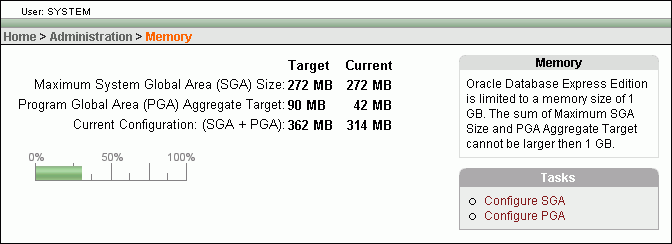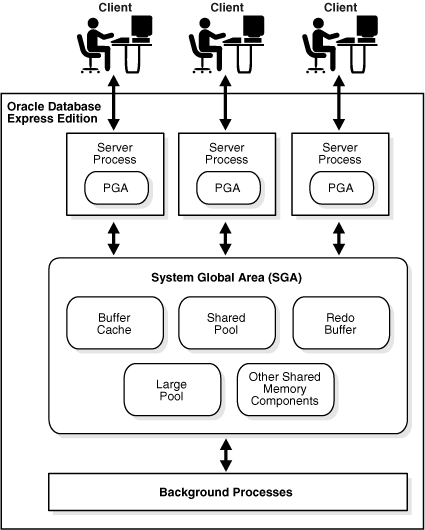To change SGA and PGA size in Oracle, alter the parameters in the initialization parameter file and restart the database. Managing the SGA and PGA size is crucial for efficient performance and resource allocation in Oracle databases.
The System Global Area (SGA) is a shared memory region that stores data and control information, while the Program Global Area (PGA) is a process-specific memory region. By adjusting these sizes, you can optimize memory usage and improve database performance.
We will discuss how to change the SGA and PGA size in Oracle databases.

Credit: m.youtube.com
Understanding Sga And Pga
In this section, we will delve into the key concepts of Understanding SGA and PGA in Oracle. It is essential to comprehend these concepts to efficiently manage and optimize the performance of your Oracle database. Let’s start by understanding what SGA and PGA stand for and their significance.
What Is Sga?
SGA, which stands for System Global Area, is a shared memory structure in Oracle that stores data and control information for an instance. It contains critical components like shared pool, buffer cache, redo log buffer, and more. The size of the SGA greatly influences the overall performance of your database.
What Is Pga?
PGA, which stands for Program Global Area, is a private memory area in Oracle allocated for each server process. It stores data and control information related to the individual processes, like private SQL areas and session memory. The PGA size plays a significant role in determining the efficiency of the server processes.

Credit: infohub.delltechnologies.com
Factors Affecting Oracle Performance
Sga And Pga Size
One significant factor that directly impacts the performance of an Oracle database is the size of the System Global Area (SGA) and Program Global Area (PGA). These memory areas play a crucial role in managing data and executing queries efficiently. By optimizing the SGA and PGA sizes, you can improve the overall performance of your Oracle database.
Database Workload
Another crucial factor affecting Oracle performance is the workload placed on the database. The type and intensity of database operations can heavily impact its performance. Different workloads, such as transactional or analytical, require different configuration settings to ensure optimal performance. Understanding the database workload is essential for making informed decisions regarding SGA and PGA sizes and other performance-related settings.
Hardware Resources
The hardware resources available to your Oracle database also play a crucial role in its overall performance. The amount of physical memory, CPU power, and disk I/O capacity directly impact the database’s ability to handle concurrent users and process large datasets efficiently. Properly aligning the SGA and PGA sizes with the available hardware resources ensures that the database can utilize the hardware to its maximum potential.
Keep in mind that finding the optimal SGA and PGA sizes is a balancing act. You need to consider the specific characteristics of your database workload, available hardware resources, and other factors to achieve the desired performance. Regular monitoring and tuning are crucial to maintain optimal performance over time.
Optimizing Oracle Performance By Adjusting Sga Size
One of the key factors that can greatly impact the performance of an Oracle database is the System Global Area (SGA) size. The SGA is a shared memory region that stores data and control information for Oracle instances. By properly adjusting the SGA size, database administrators can optimize the performance of Oracle databases and enhance overall system efficiency. In this blog post, we will explore how to change SGA and PGA sizes in Oracle, focusing on the subheading: Optimizing Oracle Performance by Adjusting SGA Size.
Determining Current Sga Size
To determine the current SGA size in Oracle, you can use the following query:
SELECT FROM V$SGA;This query will provide information about the various components of the SGA, such as the buffer cache size, shared pool size, and large pool size. By analyzing these values, you can estimate the current SGA size and identify any potential areas for optimization.
Analyzing Performance Metrics
Before making any adjustments to the SGA size, it is important to analyze the performance metrics of your Oracle database. This will help you understand the current system behavior and identify any performance bottlenecks. Some key performance metrics to consider include:
- Database response time
- CPU and memory utilization
- Buffer cache hit ratio
- Shared pool utilization
By monitoring these metrics using Oracle performance monitoring tools or scripts, you can gain valuable insights into the database’s performance and make informed decisions regarding SGA sizing.
Increasing Sga Size
If your analysis indicates that the current SGA size is inadequate for optimal performance, you can increase it by modifying the initialization parameter file (init.ora or spfile). The following steps outline the process:
- Backup your initialization parameter file
- Find the SGA-related parameters, such as SGA_TARGET or SGA_MAX_SIZE
- Increase the parameter value to the desired SGA size
- Save the changes and restart the Oracle database
It is important to note that increasing the SGA size requires sufficient memory resources on the server. Therefore, it is recommended to consult with your system administrator or allocate additional memory if necessary.
Testing And Monitoring
After increasing the SGA size, it is crucial to test and monitor the performance of your Oracle database to ensure that the changes have a positive impact. This can be achieved by running workload simulations or load tests and monitoring the relevant performance metrics.
Continuously monitor the database’s performance, focusing on response time, resource utilization, and cache hit ratios. If any issues or performance degradation is observed, you may need to further adjust the SGA size or consider other optimization techniques.
Optimizing Oracle performance by adjusting SGA size can significantly improve the efficiency and responsiveness of your database. By carefully determining the current SGA size, analyzing performance metrics, increasing the SGA size, and thoroughly testing and monitoring the changes, you can maximize the performance of your Oracle database and provide a smooth user experience.
Optimizing Oracle Performance By Adjusting Pga Size
As an Oracle database administrator, one of your primary responsibilities is to ensure optimal performance for your database system. One way to achieve this is by fine-tuning the memory allocated to the Program Global Area (PGA). The PGA is a memory region dedicated to each server process, allowing it to efficiently execute SQL statements and perform various memory-intensive tasks. By analyzing the current PGA size, monitoring memory usage, and adjusting PGA parameters, you can significantly enhance the performance of your Oracle database. In this article, we will explore the process of optimizing Oracle performance by adjusting the PGA size.
Determining Current Pga Size
Before diving into the optimization process, it is essential to determine the current PGA size for your Oracle database. You can obtain this information by querying the appropriate data dictionary views or using the Oracle Enterprise Manager (OEM). To retrieve the PGA size using SQL, execute the following query:
SELECT name, bytes/1024/1024 AS size_mb
FROM v$statname s, v$sesstat ss, (SELECT SID FROM v$mystat WHERE ROWNUM=1) m
WHERE s.STATISTIC# = ss.STATISTIC# AND ss.SID = m.SID AND s.name = 'session pga memory'
ORDER BY size_mb DESC;This query will provide you with the current PGA size in megabytes (MB). With this information in hand, you can proceed to analyze the memory usage and identify potential areas for optimization.
Analyzing Memory Usage
An important step in optimizing the PGA size is understanding how memory is being utilized in your Oracle database. By analyzing the memory usage patterns, you can identify any excessive memory allocations or inefficient memory consumption. To do this, consider the following techniques:
- Oracle AWR Reports: Utilize the Automatic Workload Repository (AWR) reports to gather detailed information about memory usage in different time periods. These reports provide valuable insights into memory allocation and can help identify potential optimization areas.
- Active Session History (ASH) Reports: The ASH reports offer a granular view of how memory is being used during active database sessions. This information can help pinpoint specific SQL statements or database activities that require excessive PGA memory.
- Monitoring PGA Memory Advisors: Oracle provides PGA memory advisors that can be accessed through the AWR or the DBMS_WORKLOAD_REPOSITORY package. These advisors offer recommendations for optimal PGA memory allocation based on historical workload patterns and can guide you in making informed adjustments.
By leveraging these analysis techniques, you can gain a comprehensive understanding of how memory is being utilized in your Oracle database and identify areas where PGA size adjustments may be beneficial.
Adjusting Pga Parameters
After analyzing the memory usage and identifying potential optimization areas, it is time to take action by adjusting the PGA parameters. The primary parameters that control PGA memory allocation are:
| Parameter | Description |
|---|---|
| pga_aggregate_target | Specifies the target aggregate PGA memory allocated across all server processes |
| pga_aggregate_limit | Controls the maximum PGA memory that can be allocated |
By adjusting these parameters, you can increase or decrease the PGA memory allocation based on your analysis findings. However, it is essential to exercise caution and keep in mind the overall system performance and resource availability. Always monitor the impact of the adjustments and make further fine-tuning as necessary.
Implications And Considerations
While adjusting the PGA size can significantly enhance Oracle performance, it is crucial to be aware of the implications and considerations associated with this process. Some key points to keep in mind include:
- Resource Constraints: Adjusting PGA size may require adequate system resources (e.g., memory) to accommodate the increased memory allocation. Ensure that sufficient resources are available before making any adjustments.
- Testing and Validation: It is crucial to thoroughly test and validate the impact of PGA size adjustments before applying them to production environments. Use test environments to simulate the workload and assess the performance improvements achieved.
- Performance Monitoring: Continuously monitor the database performance after making PGA size adjustments. This monitoring will help you identify any unforeseen impacts or areas that may require further optimization.
By carefully considering these implications and considerations, you can effectively optimize Oracle performance by adjusting the PGA size and ensure maximum efficiency for your database system.

Credit: docs.oracle.com
Frequently Asked Questions Of How To Change Sga And Pga Size In Oracle
Faq 1: What Does Sga Stand For In Oracle?
The System Global Area (SGA) in Oracle is a shared memory region that stores data and control information for the Oracle database instance. It includes the database buffer cache, shared SQL area, and other components necessary for efficient database operation.
Faq 2: How Can I Change The Sga Size In Oracle?
To change the SGA size in Oracle, you can modify the relevant parameters in the initialization parameter file (init. ora) or use the ALTER SYSTEM statement. Adjusting parameters like DB_CACHE_SIZE, SHARED_POOL_SIZE, and PGA_AGGREGATE_TARGET can help optimize the SGA size according to your database needs.
Faq 3: What Is Pga In Oracle?
Program Global Area (PGA) refers to the memory region in Oracle that is used by a single database connection or session. It stores session-specific data such as sort areas, private SQL areas, and control structures. PGA size can be adjusted using the PGA_AGGREGATE_TARGET parameter to optimize memory usage in Oracle.
Faq 4: How Can I Modify The Pga Size In Oracle?
To modify the PGA size in Oracle, you can use the PGA_AGGREGATE_TARGET initialization parameter or the ALTER SESSION statement. By adjusting this parameter, you can control the amount of memory allocated for session-specific operations like sorting and hash joins, ensuring efficient memory utilization in your Oracle database.
Conclusion
To sum up, altering SGA and PGA sizes in Oracle can have a significant impact on system performance and overall efficiency. By carefully adjusting these memory components, administrators can optimize resource allocation and enhance database operations. Remember to consider the specific requirements of your system and workload to achieve the best results.
Stay proactive in monitoring and fine-tuning these parameters to ensure smooth functioning of your Oracle environment. Happy optimizing!


